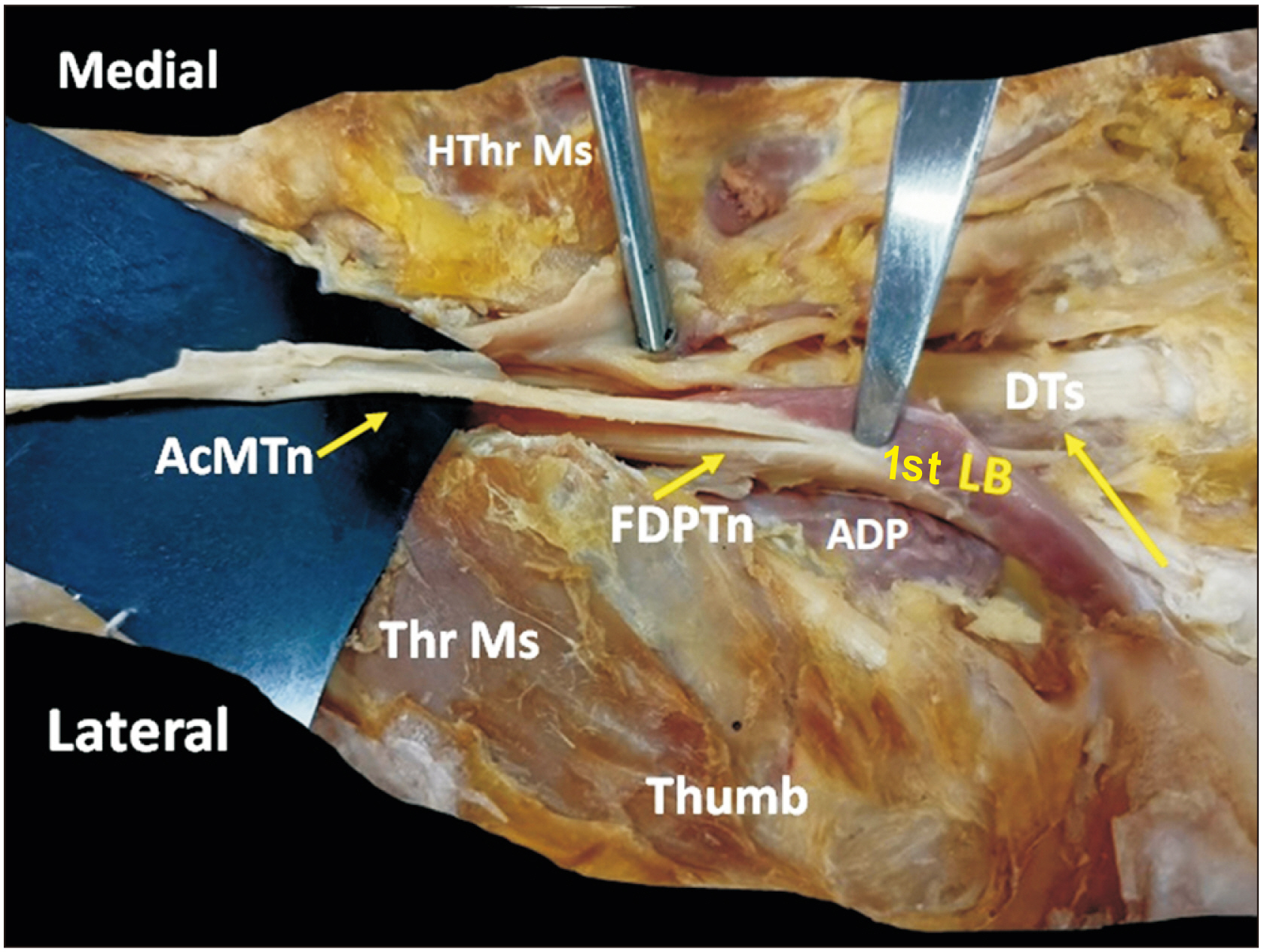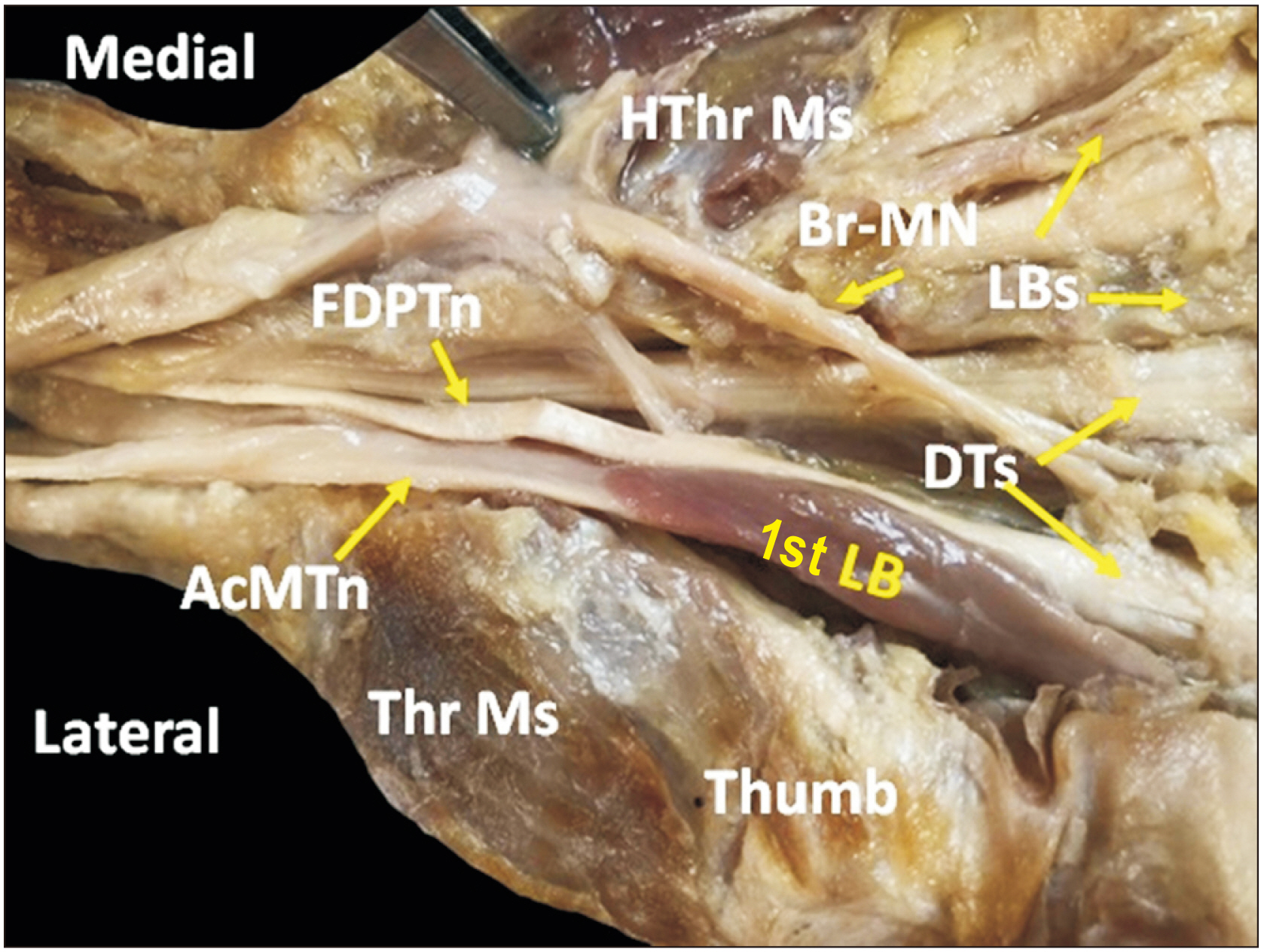Anat Cell Biol.
2023 Mar;56(1):150-154. 10.5115/acb.22.141.
An accessory muscle of flexor digitorum profundus with bipennate first lumbrical: a unique variation of clinical significance
- Affiliations
-
- 1Department of Anatomy, All India Institute of Medical Sciences, Hyderabad, Telangana, India
- KMID: 2540995
- DOI: http://doi.org/10.5115/acb.22.141
Abstract
- During the deep dissection of the front of the forearm, an anomalous accessory muscle in relation to the flexor digitorum profundus (FDP) muscle was observed in the right forearm. The accessory muscle consisted of a spindle-shaped muscle belly with a long tendon underneath the flexor pollicis longus muscle. When followed distally, the accessory muscle tendon was found lateral to the FDP tendon for the index finger and entered the palm deep to the flexor retinaculum. In the palm, we encountered the first lumbrical muscle as a bipennate muscle taking origin from the adjacent sides of the middle of the tendons of FDP and accessory muscle tendon. After giving origin to first lumbrical muscle, the accessory muscle got merged with the tendon of FDP for index finger. Understanding this kind of variation is required for radiologists and hand surgeons for diagnostic purposes and while performing corrective surgical procedures.
Keyword
Figure
Reference
-
References
1. Cıftçıoğlu E, Kopuz C, Corumlu U, Demır MT. 2011; Accessory muscle in the forearm: a clinical and embryological approach. Anat Cell Biol. 44:160–3. DOI: 10.5115/acb.2011.44.2.160. PMID: 21829760. PMCID: PMC3145845.
Article2. Biant LC. Standring S, editor. 2016. Elbow and the forearm. Gray's anatomy. 41st ed. Elsevier;Philadelphia: p. 837–861.3. Kumar S, Verma R, Mehra RD. 2016; An anomalous origin of accessory head of flexor digitorum profundus in forearm: a rare variant. J Anat Soc India. 65(Suppl 1):S73–5. DOI: 10.1016/j.jasi.2016.04.001.
Article4. Wahba MY, Singh GD, Lozanoff S. 1998; An anomalous accessory flexor digiti minimi profundus muscle: a case study. Clin Anat. 11:55–9. DOI: 10.1002/(SICI)1098-2353(1998)11:1<55::AID-CA9>3.0.CO;2-R. PMID: 9445099.
Article5. Jones M, Abrahams PH, Sañudo JR, Campillo M. 1997; Incidence and morphology of accessory heads of flexor pollicis longus and flexor digitorum profundus (Gantzer's muscles). J Anat. 191(Pt 3):451–5. DOI: 10.1046/j.1469-7580.1997.19130451.x. PMID: 9419002. PMCID: PMC1467702.
Article6. Mangini U. 1960; Flexor pollicis lungus muscle. Its morphology and clinical significance. J Bone Joint Surg Am. 42-A:467–70. DOI: 10.2106/00004623-196042030-00010. PMID: 13853793.7. Wood J. 1868; XVII. Variations in human myology observed during the winter session of 1867-68 at King's College, London. Proc R Soc Lond. 16:483–525. DOI: 10.1098/rspl.1867.0110.
Article8. Kida M. 1988; The morphology of Gantzer's muscle, with special reference to the morphogenesis of the flexor digitorum superficialis. Kaibogaku Zasshi. 63:539–46. Japanese.9. Macalister A. 1875; Additional observations on muscular anomalies in human anatomy. (Third series) with a catalogue of the principal muscular variations hitherto published. Trans R Ir Acad. 25:1–134.10. Le Double AF. 1897. Treatise on the variations of the muscular system of man and their significance from the point of view of zoological anthropology. Schleicher frères;Paris:11. Parsons FG. 1898; The muscles of mammals, with special relation to human myology: a course of lectures delivered at the Royal College of Surgeons of England. J Anat Physiol. 32(Pt 4):721–52. PMID: 17232340. PMCID: PMC1327923.12. Bhavya BS, Myageri M, Smitha M. 2016; Accessory head of flexor digitorum profundus: a case study. Int J Anat Res. 4:2931–5. DOI: 10.16965/ijar.2016.376.
Article13. El Domiaty MA, Zoair MM, Sheta AA. 2008; The prevalence of accessory heads of the flexor pollicis longus and the flexor digitorum profundus muscles in Egyptians and their relations to median and anterior interosseous nerves. Folia Morphol (Warsz). 67:63–71. PMID: 18335416.14. Testut L. 1884. Muscle abnormalities in humans. Masson;Paris: p. 454–89.15. Nayak SR, Ramanathan L, Prabhu LV, Raju S. 2007; Additional flexor muscles of the forearm: case report and clinical significance. Singapore Med J. 48:e231–3. PMID: 17657373.
- Full Text Links
- Actions
-
Cited
- CITED
-
- Close
- Share
- Similar articles
-
- A case report of an accessory flexor digitorum profundus indicis contributing the first lumbrical
- Double Gantzer's Muscles by Four Muscle Bellies and Its Clinical Significance: A Case Report
- The prevalence and distribution of the variants of Gantzer’s muscle: a meta-analysis of cadaveric studies
- Variations of the Lumbrical Muscles in Hands of Koreans
- Attritional rupture of the flexor digitorum profundus due to pisotriquetral osteoarthritis: a case report and literature review




